Prostate Cancer Radiation Simulation Procedure - Patient Instructions
In this video, we review how rectum and bladder filling can affect accuracy and side effects from radiation treatment.
We also review some standard instructions on things patients can do to help doctors achieve the best possible treatment.
Read the full video transcript below:
Before starting radiation to the prostate or prostate bed, all men must undergo a special type of CAT scan called a simulation or a mapping scan.
The simulation scan allows your doctor to get very accurate measurements of the size and location of your internal organs. However, there are some things you, as the patient, can do to improve both the accuracy and reduce the side effects of radiation.
Before we review the instructions, let's do an overview of the anatomy of the pelvis.
This is a side view of the pelvis showing up top the lowest part of the lumbar spine, and then on the bottom, a side view of the sacrum or the tailbone. The rectum is a tube-like organ that sits right in front of the sacrum, and just in front of that is the prostate or prostate bed, which is the target of radiation. The bladder, which collects urine, sits just on top of the prostate.
Next, we'll review how the filling of both the rectum and the bladder can affect both the accuracy and side effects from radiation.
Under not ideal circumstances, the rectum is full, and the bladder is empty. A rectum full of stool will bulge into and press against the prostate gland or even push into the prostate bed. A completely empty bladder will deflate and sit atop the prostate like an empty balloon or even pull inside the prostate bed. In this scenario, the rectum and the bladder are both getting more radiation dose than is necessary, which can increase the risk of side effects.
Under ideal circumstances, the rectum is empty, and the bladder is comfortably full. In this circumstance, some space is created between the rectum and the prostate or prostate bed. This reduces day-to-day changes in the exact location of the gland, which improves accuracy of treatment, and it also reduces the dose of radiation to the rectum, potentially reducing side effects. When the bladder is comfortably full of urine, it inflates like a balloon and pulls up and away from the prostate gland, which again creates some space, reduces the dose of radiation, and reduces the risk of side effects.
This is not medical advice. Talk to your doctor before making any medical decisions.

.jpg)
.jpg)
%20Thumbnail.png)







.jpg)
.png)


.jpeg)








.webp)

